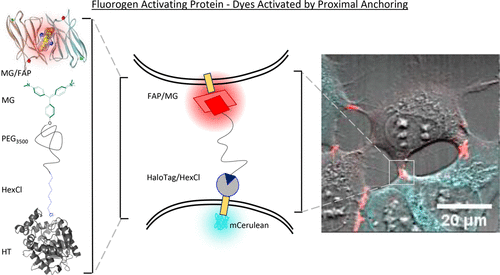当前位置:
X-MOL 学术
›
ACS Chem. Biol.
›
论文详情
Our official English website, www.x-mol.net, welcomes your
feedback! (Note: you will need to create a separate account there.)
Protein Proximity Observed Using Fluorogen Activating Protein and Dye Activated by Proximal Anchoring (FAP-DAPA) System.
ACS Chemical Biology ( IF 3.5 ) Pub Date : 2020-07-28 , DOI: 10.1021/acschembio.0c00419 M Alexandra Carpenter 1 , Yi Wang 2 , Cheryl A Telmer 2, 3 , Brigitte F Schmidt 3 , Zhipeng Yang 2 , Marcel P Bruchez 1, 2, 3
ACS Chemical Biology ( IF 3.5 ) Pub Date : 2020-07-28 , DOI: 10.1021/acschembio.0c00419 M Alexandra Carpenter 1 , Yi Wang 2 , Cheryl A Telmer 2, 3 , Brigitte F Schmidt 3 , Zhipeng Yang 2 , Marcel P Bruchez 1, 2, 3
Affiliation

|
The development and function of tissues, blood, and the immune system is dependent upon proximity for cellular recognition and communication. However, the detection of cell-to-cell contacts is limited due to a lack of reversible, quantitative probes that can function at these dynamic sites of irregular geometry. Described here is a novel chemo-genetic tool developed for fluorescent detection of protein–protein proximity and cell apposition that utilizes the Fluorogen Activating Protein (FAP) in combination with a Dye Activated by Proximal Anchoring (DAPA). The FAP–DAPA system has two protein components, the HaloTag and FAP, expressed on separate protein targets or in separate cells. The proteins function to bind and activate a compound that has the hexyl chloride (HexCl) ligand connected to malachite green (MG), the FAP fluorogen, via a poly(ethylene glycol) spacer spanning up to 28 nm. The dehalogenase protein, HaloTag, covalently binds the HexCl ligand, locally concentrating the attached MG. If the FAP is within range of the anchored fluorogen, it will bind and activate MG specifically when the bath concentration is too low to saturate the FAP receptor. A new FAP variant was isolated with a 1000-fold reduced KD of ∼10–100 nM so that the fluorogen activation reports proximity without artificially enhancing it. The system was characterized using purified FRB and FKBP fusion proteins and showed a doubling of fluorescence upon rapamycin induced complex formation. In cocultured HEK293 cells (HaloTag and FAP-expressing) fluorescence increased at contact sites across a broad range of labeling conditions, more reliably providing contact-specific fluorescence activation with the lower-affinity FAP variant. When combined with suitable targeting and expression constructs, this labeling system may offer significant improvements in on-demand detection of intercellular contacts, potentially applicable in neurological and immunological synapse measurements and other transient, dynamic biological appositions that can be perturbed using other labeling methods that stabilize these interactions.
中文翻译:

使用由近端锚定 (FAP-DAPA) 系统激活的荧光素活化蛋白和染料观察到的蛋白质邻近度。
组织、血液和免疫系统的发育和功能依赖于细胞识别和通讯的接近度。然而,由于缺乏可以在这些不规则几何形状的动态位点起作用的可逆定量探针,细胞间接触的检测受到限制。这里描述的是一种新型化学遗传工具,用于荧光检测蛋白质-蛋白质接近和细胞并置,该工具利用荧光激活蛋白 (FAP) 与近端锚定激活染料 (DAPA) 结合使用。FAP-DAPA 系统具有两种蛋白质成分,即 HaloTag 和 FAP,在不同的蛋白质靶标或不同的细胞中表达。蛋白质的功能是结合和激活一种化合物,该化合物具有与孔雀石绿 (MG)、FAP 荧光素相连的己基氯 (HexCl) 配体,通过跨度高达 28 nm 的聚(乙二醇)间隔物。脱卤素酶蛋白 HaloTag 与 HexCl 配体共价结合,局部浓缩附着的 MG。如果 FAP 在锚定荧光素的范围内,它会在浴液浓度太低而无法使 FAP 受体饱和时特异性地结合并激活 MG。一个新的 FAP 变体被分离出来,减少了 1000 倍KD _约为 10-100 nM,因此荧光原激活报告接近度而不人为增强它。该系统使用纯化的 FRB 和 FKBP 融合蛋白进行了表征,并在雷帕霉素诱导的复合物形成时显示出双倍的荧光。在共培养的 HEK293 细胞(HaloTag 和 FAP 表达)中,在广泛的标记条件下,接触位点的荧光增加,更可靠地提供具有较低亲和力 FAP 变体的接触特异性荧光激活。当与合适的靶向和表达结构相结合时,该标记系统可以显着改进细胞间接触的按需检测,可能适用于神经和免疫突触测量以及其他瞬态,
更新日期:2020-09-20
中文翻译:

使用由近端锚定 (FAP-DAPA) 系统激活的荧光素活化蛋白和染料观察到的蛋白质邻近度。
组织、血液和免疫系统的发育和功能依赖于细胞识别和通讯的接近度。然而,由于缺乏可以在这些不规则几何形状的动态位点起作用的可逆定量探针,细胞间接触的检测受到限制。这里描述的是一种新型化学遗传工具,用于荧光检测蛋白质-蛋白质接近和细胞并置,该工具利用荧光激活蛋白 (FAP) 与近端锚定激活染料 (DAPA) 结合使用。FAP-DAPA 系统具有两种蛋白质成分,即 HaloTag 和 FAP,在不同的蛋白质靶标或不同的细胞中表达。蛋白质的功能是结合和激活一种化合物,该化合物具有与孔雀石绿 (MG)、FAP 荧光素相连的己基氯 (HexCl) 配体,通过跨度高达 28 nm 的聚(乙二醇)间隔物。脱卤素酶蛋白 HaloTag 与 HexCl 配体共价结合,局部浓缩附着的 MG。如果 FAP 在锚定荧光素的范围内,它会在浴液浓度太低而无法使 FAP 受体饱和时特异性地结合并激活 MG。一个新的 FAP 变体被分离出来,减少了 1000 倍KD _约为 10-100 nM,因此荧光原激活报告接近度而不人为增强它。该系统使用纯化的 FRB 和 FKBP 融合蛋白进行了表征,并在雷帕霉素诱导的复合物形成时显示出双倍的荧光。在共培养的 HEK293 细胞(HaloTag 和 FAP 表达)中,在广泛的标记条件下,接触位点的荧光增加,更可靠地提供具有较低亲和力 FAP 变体的接触特异性荧光激活。当与合适的靶向和表达结构相结合时,该标记系统可以显着改进细胞间接触的按需检测,可能适用于神经和免疫突触测量以及其他瞬态,











































 京公网安备 11010802027423号
京公网安备 11010802027423号